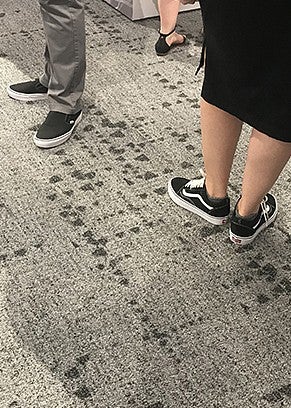Before their third birthdays, children already have an adult-like preference for visual fractal patterns commonly seen in nature, report University of Oregon researchers.
That discovery emerged among children raised in a world of Euclidean geometry, such as in houses with rooms constructed with straight lines in a simple nonrepeating manner, said Kelly E. Robles, a doctoral student in the Department of Psychology.
“Unlike early humans who lived outside on savannahs, modern-day humans spend the majority of their early lives inside these manmade structures,” Robles said. “So, since children are not heavily exposed to these natural, low-to-moderate complexity fractal patterns, this preference must come from something earlier in development or perhaps it is innate.”
The study, led by Robles, published online Nov. 25 in the Nature journal Humanities and Social Sciences Communication.
In it, her team explored how individual differences in processing styles may account for trends in fractal fluency. Previous research suggested that such a preference is built by environmental and developmental factors across the lifespan.
In the study, researchers exposed participants – 82 adults, ages 18-33, and 96 children, ages 3-10 – to images of fractal patterns, exact and statistical, ranging in complexity on computer screens.
Exact fractals are highly ordered such that the same basic pattern repeats exactly at every scale and may possess spatial symmetry such as that seen in snowflakes. Statistical fractals, in contrast, repeat in a similar but not exact fashion across scale and do not possess spatial symmetry, as seen in coastlines, clouds, mountains, rivers and trees. Both forms appear in art across many cultures.
When viewing the patterns, Robles said, subjects chose favorites between pairs of images that differed in complexity. When looking at exact fractal patterns, selections involved different pairs of snowflake-like or tree-branch-like images. For the statistical fractals, selections involved choosing between pairs of cloud-like images.
“Since people prefer a balance of simplicity and complexity, we were looking to confirm that people preferred low-to-moderate complexity in statistically repeating patterns, and that the presence of order in exact repeating patterns allowed for a tolerance of and preference for more complex patterns,” she said.
Although there were differences in the preferences of adults and children, the overall trend was similar. Exact patterns with greater complexity were more preferred, while preference for statistical patterns peaked at low-moderate complexity and then decreases with additional complexity.
In subsequent steps, the UO team was able to rule out the possibility that age-related perceptual strategies or biases may have driven different preferences.

The aesthetic experience of viewing nature’s fractals holds huge potential benefits, ranging from stress-reduction to refreshing mental fatigue, said co-author Richard Taylor, professor and head of the UO’s Department of Physics.
“Nature provides these benefits for free, but we increasingly find ourselves surrounded by urban landscapes devoid of fractals,” he said. “This study shows that incorporating fractals into urban environments can begin providing benefits from a very early age.”
Taylor, in his own research, is using fractal-inspired designs in an effort to create implants for the eyes to treat macular degeneration. He and co-author Margaret Sereno, professor of psychology and director of the Integrative Perception Lab, also have published on the positive aesthetic benefits of installing fractal solar panels and window blinds.
Fractal carpets, recently installed in the UO’s Phil and Penny Knight Campus for Accelerating Scientific Impact, are seen in the new facility’s virtual grand opening tour. Sereno and Taylor also are collaborating on future applications with Ihab Elzeyadi, a professor in the UO’s Department of Architecture.
Other co-authors with Robles, Taylor and Sereno on the new paper were Nicole Liaw, a former research assistant in the Department of Psychology who received a bachelor’s degree in 2018, and Dare Baldwin, a developmental psychologist in the Department of Psychology and head of the Acquiring Minds Lab.
—By Jim Barlow, University Communications


